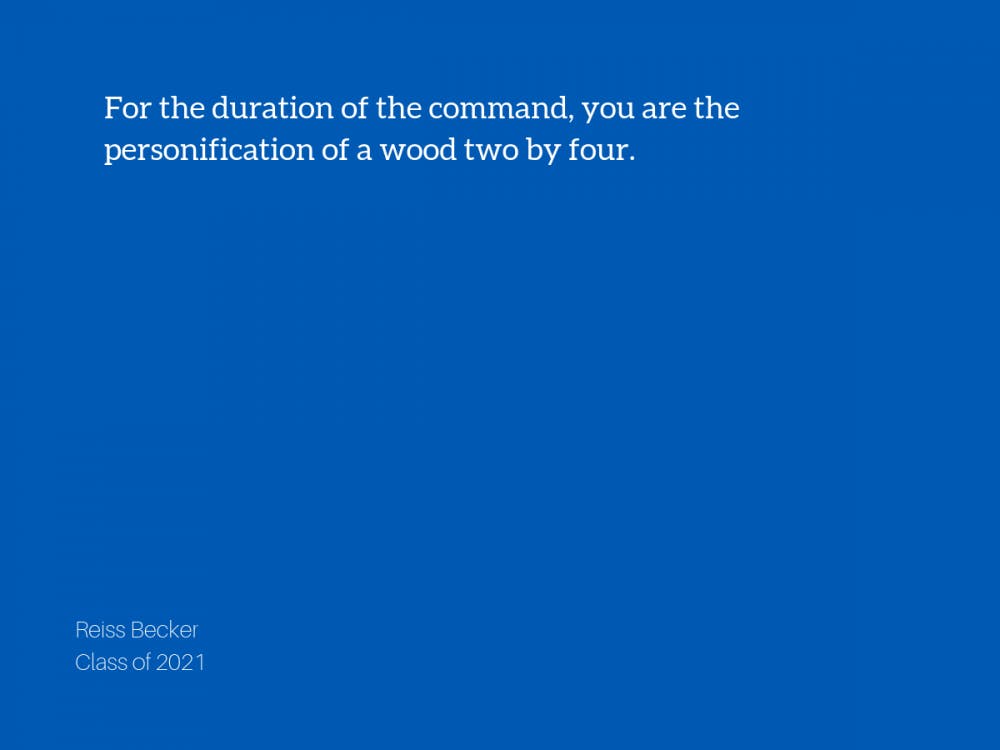As Drill Sergeant paced through our formation, peering into the stationary eyes of the assembled Cadets, he periodically barked: “Thinkin’ and blinkin’ Cadets! That is all that is authorized at the position of attention.”
The position of attention is a staple of the Army. A sign of respect for a superior officer, the position involves keeping the body absolutely still with hands straight along the trouser seams, feet pointed out at 45 degree angles, and head and eyes forward. My platoon was taught how to stand “at attention” on the very first day of Army ROTC Basic Camp at Fort Knox, KY, but we didn’t truly learn for at least a week. As with many lessons, Second Platoon learned the hard way.
When Drill Sergeant would place us at the position of attention, inevitably someone would wipe their nose. Pushups. Or maybe check their watch. Pushups. Or crack their neck. Pushups. Each set of disciplinary excercises featured an accompanying wisecrack ( “Y’all are gonna get smart or y’all are gonna get stupid strong!”). It took time, but we learned. We learned from the wisecracking Drill Sergeant, from the burn in our muscles, and from the sweat stinging our eyes that you never move at the position of attention. For the duration of the command, you are the personification of a wood two by four.
Mastering the position of attention requires acute attention to detail. Attention to detail because Drill Sergeants are constantly playing a game of “Where’s Waldo.” Except in this version, Waldo does lots of pushups upon his unfortunate discovery. As we stood in formation, Drill Sergeants would patrol the perimeter searching for that one dreaded “individual,” that lone Cadet who dared defile the integrity of the formation with their lackadaisical arrogance. If we we’re all paying close attention to detail, then the Drill Sergeant would abandon his search unsatisfied. And if just one person was not? Pushups for all.
The position of attention also requires great discipline. The type of discipline that allows you to ignore the need to scratch your head because there’s an itch or shift your posture because your hips are uncomfortable. Army discipline teaches you to ignore the “because” and focus intently on the validity of the action in question—“is this allowed right now?” At the position of attention, the answer is always “no.”
Frequently, Drill Sergeant would bark, “It is physically impossible to move at the position of attention!” and sometimes, in my cheekier moments, I would think to myself, “Well that’s not literally true, I could move my arm right now if I wanted to.” But after plenty of punitive pushups, I smothered my inner brat and treated Drill Sergeant’s statement like the second coming of “2 + 2 = 4.”
Once, I was standing at attention in the front row of the formation. Before me, a female Drill Sergeant sat on a camp stool surveying the Cadets before her. Suddenly, with an intent look upon her face, in a calm voice, she said “Cadet Becker, find your peace at the position of attention.”
If I could, I would have scrunched my face in confusion. Find my peace? I was simply trying to find my anonymity! In that moment, my only desire was not to be singled out for a silly mistake that would bring the pain down on everyone else. In the same steady tone, she instructed me to “relax in position, let the tension in your body release, and breathe in through your mouth and out through your nose.” For a few minutes I stood there, breathing in and out to the rhythm of her steady cadence. Slowly, I quieted my thoughts and focused on maintaining an even pace of breath. Almost without my noticing, the paranoia of being singled out faded away. “There you go, Cadet. Now just remember to keep your hands fixed to your trousers and you’ll have it almost perfect.” I had found my peace at the position of attention.
At the graduation ceremony on the final day of Basic Camp we stood fast at the position of attention for nearly twenty minutes straight. When I first arrived at Fort Knox, standing at attention for that amount of time would have been unbearable. I would have been distracted by a thousand different inconveniences—from my parched mouth to the itch in the small of my back. But after 31 days of training, I had learned better than to fixate on such nuisances. I had developed a measure of discipline over body and mind. So, once more, I assumed the position of attention. I took a deep breath and turned my animated limbs into iron rods. I aligned my hands with the seams of my trousers and placed my feet at neat, 45 degree angles. Finally, I moved my head and eyes forward and fixed my gaze on a tree in the distance. Having assumed the position of attention properly, I stood there doing nothing besides “thinkin’ and blinkin’.”
Reiss Becker is a Trinity junior. His column, “roused rabble,” runs on alternate Thursdays.
Get The Chronicle straight to your inbox
Signup for our weekly newsletter. Cancel at any time.

